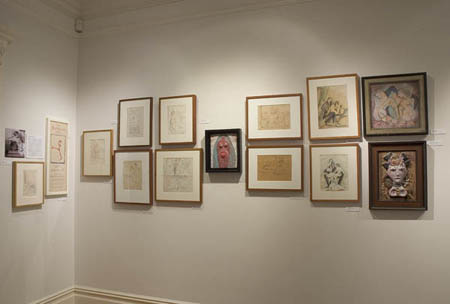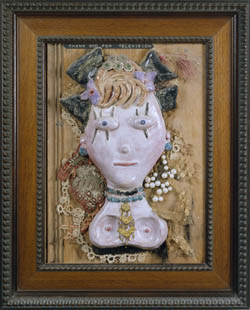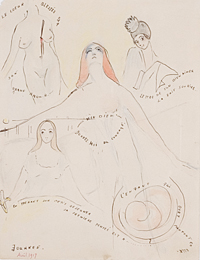|
|
|
|
|
|
|
|
|
|
|
|
|
|
|
|
|
|
|
|
|
|
|
|
|
|
|
|
|
|
|
|
|
|
|
|
|
|
![[Francis Naumann]](../4logo.gif) |
|
|
|
|
|
|
|
|
|
|
|
|
|
|
|
|
|
|
|
|
|
|
|
|
|
|
 |
|
|
|
 |
|
|
|
 |
|
|
|
|
|
|
|
|
|
|
 |
|
|
|
|
|
|
|
|
|
|
|
|
|
|
|
|
|
|
|
|
|
|
|
|
|
|
|
|
|
|
|
 |
|
|
|
|
|
|
|
 |
|
|
|
|
|
|
|
|
 |
|
|
|
|
|
|
|
|
(1893-1997) Beatrice Wood’s involvement with the world of modern art began in 1916, in a chance encounter with the French painter Marcel Duchamp. At one of their first meetings, she told him that she thought modern art was something anyone could do. He invited her to try, even offering his studio as a place to work. Over the course of the next year, Duchamp served as her artistic coach, telling her what he thought was good, and what he thought was bad. He especially liked her rendition of a nude female figure emerging from her bath, which, through a slip of the tongue, she called Un peu d’eau dans du savon [A Little Water in Some Soap]. At first she tried to paint a bar of soap over what she called “the tactical position,” but Duchamp suggested she use an actual piece of soap, which he helped her to select from a store and later affix to the surface of the canvas. This work was shown in the famous 1917 Independents Exhibition, where, under a pseudonym, Duchamp submitted his infamous urinal, Fountain. Since that work was never shown, Un peu d’eau dans du savon was the most controversial work shown in the exhibition (when men discovered that such a provocative work was made by a woman, they inserted their calling cards into the frame).
|
|
|
|
|
|
|
|
|
|
|
|
|
|
![Il ne comprend pas les femmes [He Does Not Understand Women], 1926](Wood - Il ne compred pas les femmes.jpg) |
|
|
|
|
|
|
|
|
|
|
|
|
|
|
|
|
|
|
|
|
|
|
|
|
|
|
|
|
|
|
|
|
|
|
|
|
|
|
|
|
|
Wood assisted Duchamp and his friend Henri-Pierre Roché with the publication of The Blind Man, the second and last issue of a magazine that was devoted to defending the rejected Fountain. It was here that Wood wrote the oft-quoted phrase (often attributed to Duchamp): “The only works of art America has given are her plumbing and her bridges.” To celebrate the appearance of the magazine, Duchamp and his friends sponsored a costume ball and asked Wood to design a poster advertising the event. From work she had done in his studio, Duchamp chose a quickly drawn stick figure thumbing its nose to the world, an insolent gesture that would later be seen to epitomize the spirit of Dada. |
|
|
|
|
|
|
|
|
|
|
|
Il ne comprend pas les femmes [He Does Not Understand Women], 1926
Watercolor and pencil on paper, 13 5/8 x 9 12 inches |
|
|
|
|
|
|
|
|
|
|
|
|
Even after Duchamp and Roché returned to Europe, Wood remained in contact with them, and when she resumed drawing again in the mid-1920s, she sent photographs of her work to her old friends asking for their advice. The technique she developed was to render form in only partial outline, a graphic style that seems to have been derived from Art Deco. In order to improve the formal quality of her work, she invariably worked on most of her drawings while they were positioned upside-down. “Thus I feel freer in the form,” she wrote to Roché, “and am not bothered about the reality of the subject matter.” This procedure gave her a more secure feeling of compositional control, while at the same time providing the sense of detachment necessary to manipulate the color and shape of a given line to enhance or embellish the expressive power of the image. |
|
|
|
|
|
|
|
|
|
|
|
|
|
|
|
|
|
|
|
|
|
|
|
|
|
|
 |
|
|
|
|
|
|
|
|
|
|
|
|
|
|
|
Thank God for Television, ca. 1958
Glazed earthen-ware and Indian jewelry mounted on molded wood panel
15 x 10 ¾ inches |
|
|
|
|
|
|
|
|
|
|
|
|
|
|
|
|
|
|
|
|
|
|
In 1933—at the age of 40—Wood took up ceramics, developing a lusterware technique for which she became internationally known. In the 1940s, she began the production of figurative ceramic sculpture made in a consciously naïve style, works that she called “sophisticated primitives.” Often humorous, these works address complex subjects, involving themes that range from political issues to a moral commentary on the interplay between the sexes. These same themes preoccupied Wood throughout her career, especially when she took up drawing again in the mid-1970s. She continued to exhibit regularly, working daily in her home and studio in Ojai, California, until a few weeks before her death at the age of 105. |
|
|
|
|
|
|
|
|
|
|
|
|
|
![Un peut d’eau dans du savon [A Little Water in Some Soap], 1917/77](Wood - Un peut d’eau dans du savon.jpg) |
|
|
|
|
|
|
|
|
|
|
|
|
|
|
|
|
|
|
Un peut d’eau dans du savon [A Little Water in Some Soap], 1917/77
Glazed earthenware, heart-shaped bar of soap, 11 ¾ x 9 ¾ inches |
|
|
|
|
|
|
|
|
|
|
|
|
|
|
|
|
|
|
|
|
|
|
|
|
|
|
|
|
|
|
 |
|
|
|
|
|
|
|
|
|
|
|
|
|
|
|
|
|
|
|
|
|
Journée, 1917
Watercolor and pencil on paper, 10 13/16 x 8 5/6 inches |
|
|
|
|
|
|
|
|
|
|
|
|
|
|
|
|
|
|
|
|
|
|
|
|
|
|
|
|
|
|
|
|
|
|
|
|
 |
 |
 |
 |
 |
 |
 |
 |
 |
 |
 |
 |
 |
 |
 |
 |
 |
 |
 |
 |
 |
 |
 |
 |
 |
 |
 |
 |
 |
 |
 |
 |
 |
 |
 |
 |
![[Francis Naumann]](../4logo.gif)


![Il ne comprend pas les femmes [He Does Not Understand Women], 1926](Wood - Il ne compred pas les femmes.jpg)

![Un peut d’eau dans du savon [A Little Water in Some Soap], 1917/77](Wood - Un peut d’eau dans du savon.jpg)
